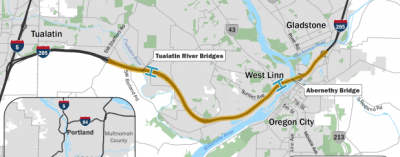Civic Response to I-205 Toll Project Environmental Assessment
To identify potential short- and long-term effects of the proposed I-205 Toll Project on the transportation system, local communities, the economy and the environment, and to identify possible solutions to mitigate negative effects, the Oregon Department of Transportation (ODOT) and the Federal Highway Administration completed an environmental assessment (EA). This assessment was posted, after which a 60-day public comment commenced (February 21-April 21, 2023).
- Read the Environmental Assessment, appendices, technical reports and a multi-lingual summary fact sheet.
- An interactive map shows the effects at studied intersections and corridors.
- ODOT produced a series of videos about the report and findings on line. Closed captions can be accessed in multiple languages.
CIty Response During Period of Public Comment
In April 2023, the City of Wilsonville raised issues of concern to the Oregon Department of Transportation (ODOT) and the Federal Highway Administration (FHwA) after reviewing the Environmental Assessment (EA) for the proposed I-205 Toll Project. In an April 20 letter to ODOT, the City detailed a set of primary issues of concern to local-area residential and business constituencies:
1. EA API analysis area is too small to capture accurately the potential traffic impacts of tolling.
The City is particularly concerned that the projected increase in PM peak-hour traffic congestion could have significant impacts to roadways and intersections south of Mountain Road, specifically the 65th/Stafford/Elligsen roads intersection, that are outside of the EA analysis area and not documented in the EA. Already the 65th/Stafford/Elligsen roads intersection is failing to meet standards during the PM peak evening rush-hour.
2. The EA fails to address adequately mitigation measures for intersections that fail to meet standards under the Build Alternatives.
The EA indicates that mitigation measures are needed, but does not address what these measures should be. The EA should address mitigation measures for the intersections not meeting standards under the Build scenario.
3. The EA fails to analyze fully traffic diversion impacts onto I-5 from traffic that seeks to avoid the I-205 tolls.
The EA appears to conclude that traffic diversion onto I-5 from drivers seeking to avoid I-205 tolls is only minimal, with increased traffic during the PM peak rush-hour. Such a small EA analysis area may be failing to capture the true, regional impact of I-205 tolls on the interstate highway system and adjacent local roads.
4. Failure to analyze the cumulative impacts of tolling all of I-205 and Metro-area I-5 as proposed in the Regional Mobility Pricing Project (RMPP) provides insufficient data to fully understand tolling impacts of the I-205 Toll Project.
ODOT’s proposed Regional Mobility Pricing Project (RMPP) should be evaluated in the cumulative analysis of the I-205 Toll EA. Better yet, ODOT/FHWA should prepare an EIS that fully evaluates both components of the Portland Metro Area Value Pricing Project. Analysis of both projects together will allow for a more comprehensive review of feasible alternatives, diversion impacts, and mitigation planning
5. Lack of detailed study of public transit alternatives and capital improvement projects to support mobility options.
The EA’s Build Alternative should be robust in design such that it has a significant effect on travel mode choice in the region. The EA indicates that transit trips increase by only 800 trips or 0.11% — barely one percent increase in transit trips. This hardly perceptible increase in transit utilization fails to meet the objectives of the EA goals for transit transportation. The EA proposes that only 27% of all projects relate to transit improvements.
This data demonstrates that the EA has failed to advance a sufficient number and quality of transit-related mitigation measures to make a meaningful, significant impact to increase transit utilization that is a primary objective of the EA Build Alternative.
Additional Responses to Environmental Assessment
Local government officials have called on the Oregon legislature to review the proposed ODOT toll program.
- April 5, 2023, Local Governments Letter to State Legislators — “The 2023 State Legislature Must Take Action on the I-205 Toll Project.” Multiple counties, local governments and transit agencies sent a letter to legislative leaders requesting a public hearing and other legislative action on the proposed I-205 Toll Project
- April 10, 2023, Clackamas County Coordinating Committee (“C4”) Letter of Comment on the I-205 Toll Project Environmental Assessment. The intergovernmental organization Clackamas County Coordinating Committee or “C4” submitted comments on issues of concern pertaining to the I-205 Toll Project and Environmental Assessment. C4 is composed of Clackamas County; the Clackamas Cities of Canby, Estacada, Gladstone, Happy Valley, Lake Oswego, Milwaukie, Molalla, Oregon City, Rivergrove, Sandy, Tualatin, West Linn, Wilsonville; Clackamas CPOs, Hamlets, and Special Districts; and Ex Officio Members including Metro, MPAC Citizen, Port of Portland, Urban and Rural Transit.
- April 12, 2023, Clackamas County Board of County Commissioners Policy Session on I-205 Toll Project Environmental Assessment. Clackamas County Commissioners held a meeting to review and discuss issues of concern with ODOT’s proposed I-205 Toll Project and the Environmental Assessment. A draft letter from the Board of County Commissioners was reviewed, and is to scheduled to include additional technical comments by County staff and retained experts.






